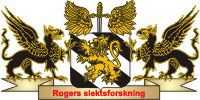|
   Back to the story
Back to the story
Torbjørn
Knudsen Svinali (1765 - 1842)
Torbjørn Knudsen was born on
Svinali farm in Tysvær, Rogaland, Norway. He died in 1842 at the
farm Meling at Talgje in Finnøy. He was son of Knud Helgesen
(1719 - 1766) and Martha (Marta) Sjursdtr. (1732 - 1794).
He has been called "the Quaker
pioneer," because he was one of the first to bring these beliefs
to Norway.
It might surprise us that none of the
children of Marta's from her first marriage to Knut Helgesen took over
the farm. It was them who belonged to the old owners with roots at Ile.
Many of their children were established at other places when Marta died.
Once again other places than the "home-farm" were preferred.
The youngest male and bachelor Torbjørn
Knutsen had, on the other hand, had not established himself permanently.
He entered the military service and went to sea. From the "Undersøkelseskommisjonen"
(a new system to recruit men to the navy) I found some of Torbjørn's
sea-carrier. In April 30 1805 he got a permission from "Sjøinnrulleringssjefen"
to travel to Sunnfjord for summer work. He got a new permission to travel
to Sunnfjord, October 22 1805, and he reported that he was back February
13 1806. But already February 2 1806, he was hired for a trip to Drammen
(reise 47), he
returned home, June 10 1806. His next trip took place, July 10 1806
(reise 144). In May 13 1807 he got a permission for a trip to Osterfjorden
with a small cargo boat with half deck and sails, named Anna Helena.
In August 14 1807 he is hired for a trip to Holland (reise 220). This
is the last thing mentioned about him in "Undersøkelseskommisjonen".
This because he was captured, September 1, 1807 in Yarmouth, Norfolk,
England.
He ended up in English captivity (on
a prison ship!) as a result of Napoleon's wars. He got well known for
taking back home the Quaker religious beliefs. Well after he was back
from prison in England, he lived not only at the home farm here (Svinali
Nedra), but also at Bringedal in Tysvær, in Sandnes "near
Stavanger" and at Høye, also in the south of Stavanger area.
He died at the farm Meling at Talgje in Finnøy, at the home of
married Marta Knutsdotter, daughter to his half-brother Knut Størkerson.
There Torbjørn took himself "flet-føring", that
means that he could live with Marta's family on the condition of inheritance.
Torbjørn did bring the Quaker
religion to his closest relatives. Siri Eriksdotter from Kringeland,
the wife of half brother Knut Størkerson, had a sister which
was married at Stakland and another sister which was married at Årek.
These two farms came together with Nedra Svinali to become the "Quaker
farms" in Søra (south) Skjold.
These new thoughts, that Torbjørn
did import, met resistance and many of the adherents did not see any
other solution for themselves, but to export them again by emigrating
to America. Many of Torbjørn's relatives were going to emigrate.
It is a possibility that all children of his half-brother Knut Størkerson
did emigrate. The exception was Størker Knutson, who took over
after his father and did run the home farm. (Tysvær bygdebok #4)
In the historical novel Cleng Peerson
written by Alfred Hauge and translated into English by Friis, the following
is said about Torbjørn as if Cleng were speaking: "... a
fellow from my home district, had been imprisoned at Chatham -- on board
a ship called the 'Belliquer.' At that time he had been a Haugean, but
during his imprisonment he had converted to the teachings of the Quakers."
Read more about Torbjørn and other
Quakers in Rogaland at Keith
Weeler's homepage. (Torbjørn Knudsen is Keith's 4th great
granduncle).
Microfilms at the National Archives
in Kristiansand:
At the National Archives in Kristiansand
they have copies of 6 microfilms from the Napoleon's wars. This is what
I found about Torbjørn, on the microfilm: Chatham, ADM/103/61
nr. 671.
-Number. 671
-By what Ship, or how taken. A Cutter
-Time when. 01 September 1807
-Place where. Yarmouth in Norfolk, England
-Name of Prize. Welforenniet
-Whether Man of War, Privateer, or Merchant-Vessel. Merchant-Vessel
-Prisoners' Names. Turbean Kneutsen
(Torbjørn Knutsen). See also Digitalarkivet.
-Quality. Seaman
-Time when received into Custody. 3 December 1807
-From what Ship, or whence received. Wool..t (Woolwat ?)
-Place of Nativity. Nth. Bergen
-DESCRIPTION.
-Age. 43
-Stature. 5/ 4 1/2
-Person.
-Visage and Complexion. Oval
-Hair. Brown
-Eyes. Blue
-Marks or Wounds.
-Exchanged, Discharged, Died, or Escaped.
Discharged
-Time when. 24 September 1814
-Whither, and by what Order if discharged. Chapman 1)
1) Østrem,
Nils Olav. Tysvær, Gard og ætt 4, Skjoldastraumen (Vol.
4 of "Tysvær Bygdebok" or local history book for "farms
and families" for Skjoldastraumen, Tysvær kommune, Rogaland
county, Norway). Stavanger, Norway: Tysvær Kommune, 1999. pp.
22,26.
Hauge, Alfred. Cleng Peerson, Volume
1 & 2, Translated from the Norwegian by Erik J. Friis. (Historical
novel/fictionalized biography originally published in 3 volumes by Gyldendal
Norsk Forlag, Oslo.). Boston: Twayne Publishers, 1975. Vol. 1, p. 239.
Johnsen, Berit Eide. Han sad i prisonen.
Universitetsforlaget 1993. Page 94, 95 and 96.
Microfilm: ADM/103/61 nr. 671. (National
Archives in Kristiansand).
Keith
Weeler's homepage
.
|



